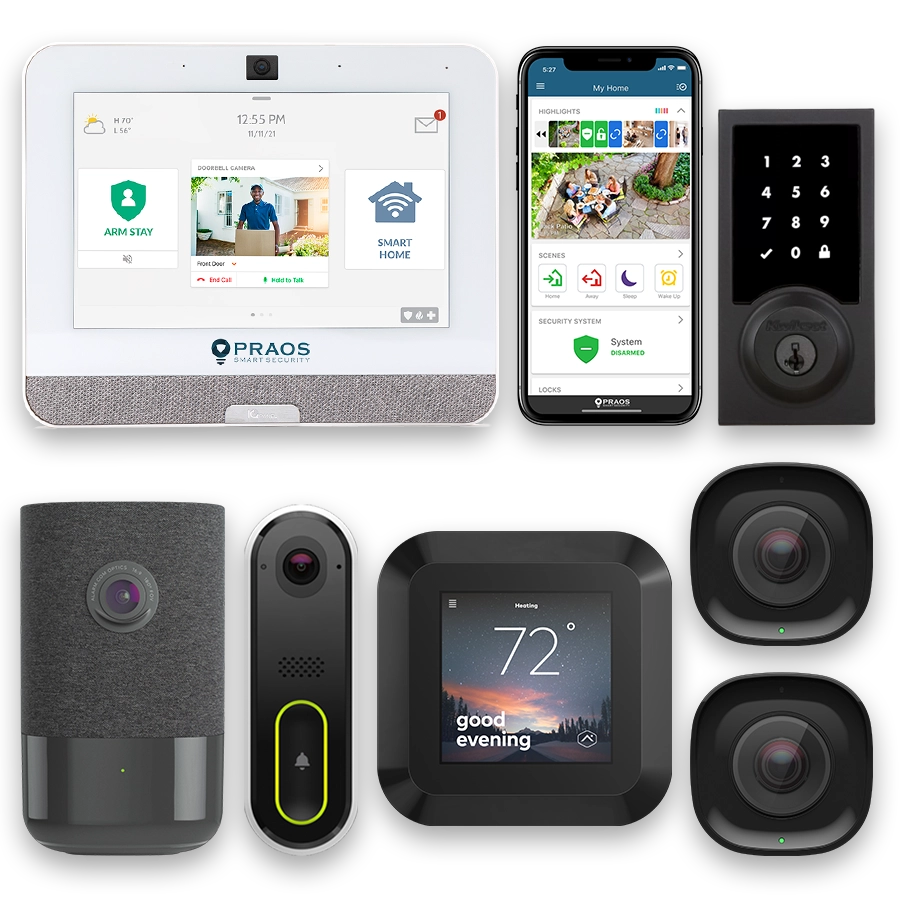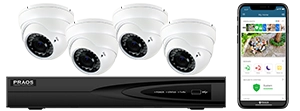Understanding Home Surveillance Needs
When it comes to choosing the best surveillance cameras for your home, it is crucial to first understand your specific security needs. This initial step will guide you in selecting the equipment that best fits your requirements and ensures maximum protection for your property.
Identifying Security Goals
The first step in determining your surveillance needs is to identify your primary security goals. Are you looking to monitor the exterior of your home, keep an eye on indoor activities, or perhaps both? Understanding your objectives helps in deciding the type and number of cameras you might require.
- Deterring potential intruders
- Monitoring specific areas (e.g., front door, backyard)
- Keeping an eye on pets, children, or elderly family members
- Gathering evidence in case of an incident
Assessing Vulnerable Areas
Another key aspect is assessing which areas of your home are most vulnerable. This involves a thorough examination of the premises to identify spots that are potential entry points for intruders or areas that need constant monitoring.
- Front and back doors
- Windows
- Garage and driveways
- Perimeters and property boundaries
Environmental Considerations
Environmental factors can greatly influence the type of surveillance cameras suitable for your home. Consider both the physical environment (e.g., indoor vs. outdoor) and, weather conditions.
| Environment | Camera Features |
|---|---|
| Indoor | Compact design, less weather-resistant |
| Outdoor | Weatherproof, night vision capabilities |
| Harsh Weather | Robust build, wide temperature range |
Technical Considerations
Additionally, consider technical aspects such as the camera’s resolution, field of view, and connectivity options.
- Resolution: Higher resolution provides clearer images.
- Field of View: A wider field of view covers more area.
- Connectivity: Wired, wireless, or hybrid.
By taking into account these factors when assessing your surveillance needs, you set a strong foundation for selecting the cameras that will best serve to protect your home and loved ones.
Types of Surveillance Cameras and Their Features
When choosing the best surveillance cameras for your home, understanding the types available and their specific features is crucial. Here’s a breakdown of the different types of surveillance cameras and what they offer.
Types of Surveillance Cameras
There are several types of surveillance cameras available in the market. Each type has its unique set of characteristics and benefits.
- Bullet Cameras: These cameras have a long cylindrical shape and are generally weatherproof, making them suitable for outdoor use. They are typically mounted on walls or ceilings and are known for their extended range of vision.
- Dome Cameras: Named for their dome-like shape, these cameras are more discreet than bullet cameras and can provide a wider field of view. They are often used indoors but can also be weatherproof for outdoor purposes.
- PTZ (Pan-Tilt-Zoom) Cameras: PTZ cameras offer rotation and zoom capabilities, allowing users to control the direction and magnification of the camera’s lens. These features make them versatile for covering larger areas.
- Wireless Cameras: These cameras connect to a Wi-Fi network and do not require a physical connection to a recording device. They offer easier installation and flexibility in camera placement.
- IP Cameras: Internet Protocol cameras transmit data over an IP network, allowing for high-resolution video recording and remote access. IP cameras can be wired or wireless.
- Hidden Cameras: Designed to blend in with the environment, hidden cameras are less noticeable and can be embedded in various objects such as clocks or smoke detectors.
Important Features to Consider
When evaluating different surveillance cameras, take into account the following key features to determine which models will best meet your home security needs:
- Resolution: Higher resolution cameras provide clearer and more detailed images. Common resolutions include 720p, 1080p, and 4K.
- Low Light Capability: Cameras with night vision or low light capabilities use infrared LEDs to capture video in darkness, which is essential for 24/7 surveillance.
- Field of View: The field of view indicates how much area the camera can cover. A wider field of view is ideal for monitoring large spaces.
- Motion Detection: This feature allows the camera to detect movement and can trigger alerts or recording, saving storage space and focusing on potential incidents.
- Audio Features: Some cameras include built-in microphones and speakers for two-way audio communication, providing additional security and interaction capabilities.
- Storage Options: Cameras can store footage locally on a microSD card or other storage devices, or on the cloud, which may require a subscription.
- Remote Access: Many modern surveillance cameras offer apps or web portals for remote viewing, allowing homeowners to monitor their property from anywhere.
By understanding the different types of surveillance cameras and their specific features, you can make an informed decision tailored to your home security needs.
Key Factors to Consider When Choosing a Surveillance Camera
Key Factors to Consider When Choosing a Surveillance Camera
When selecting a surveillance camera for your home, various factors need to be evaluated to ensure that the chosen system meets your security requirements. Below are six essential factors to consider:
1. Resolution
The resolution of a camera determines the clarity of the images and videos it captures. Higher resolution cameras provide more detail, which can be crucial for identifying people or objects. Look for cameras that offer at least 1080p HD resolution for clear and detailed footage. Some advanced models provide 4K resolution, offering even higher clarity.
2. Field of View
The field of view (FOV) is the extent of the area that a camera can capture. Cameras with a wide-angle lens can cover more area, reducing the number of cameras needed to monitor a given space. Most home surveillance cameras offer FOVs ranging from 90 degrees to 180 degrees.
3. Night Vision
Night vision capabilities are essential for monitoring low-light environments. Infrared (IR) LEDs enable cameras to see in the dark, allowing for 24/7 surveillance. Check the range of the night vision; some cameras provide night vision capabilities up to 100 feet or more.
4. Connectivity
Surveillance cameras can be wired or wireless. Wired cameras provide a stable connection and are less susceptible to interference, while wireless cameras offer easier installation and flexible placement options. Wireless cameras typically use Wi-Fi, so ensure your home network is robust enough to support the camera system.
5. Storage Options
Consider how the camera stores footage. Options include local storage (using SD cards or DVRs) and cloud storage services. Local storage ensures that data is retained on-site, while cloud storage allows for remote access and can provide an additional layer of backup. Evaluate the subscription costs and storage limits associated with cloud services.
6. Motion Detection and Alerts
Motion detection features trigger recording and send alerts when movement is detected. Advanced cameras allow for customized motion detection zones and sensitivity settings to minimize false alarms. Notifications can be sent via email, SMS, or through a mobile app, ensuring you are promptly informed of any activity.
By carefully evaluating these factors, you can choose a surveillance camera that effectively enhances the security of your home while fitting your specific needs and preferences.
Installation and Placement Best Practices
Proper installation and strategic placement of surveillance cameras are critical components for achieving optimal security coverage in your home. Ensuring that cameras are placed correctly can enhance their effectiveness in monitoring and deterring unwanted activities.
1. Choose Strategic Locations
Identify the most vulnerable areas around your home. Common locations include entry points such as doors and windows, driveways, and gardens. Positioning cameras to cover these spots will maximize surveillance coverage and deter potential intruders.
2. Optimal Camera Height
Mount cameras at a height of 8–10 feet from the ground. This height is optimal as it is high enough to avoid tampering but low enough to capture clear images of faces and details.
3. Consider Coverage Angles
Ensure that cameras are angled appropriately to cover the widest area possible without leaving blind spots. Wide-angle lenses can help in covering more area with fewer cameras, but note that they may reduce the detail of the captured image.
4. Weather Protection
If installing cameras outside, choose weatherproof models and ensure they are sheltered from extreme conditions like heavy rain or direct sunlight. Proper placement under eaves or specialized outdoor casing can protect the equipment from weather damage.
5. Proper Wiring and Power Supply
Plan the wiring and power supply routes. For wired cameras, keep wires hidden or protected to prevent tampering. Wireless cameras should be installed within range of the network signal and close to power sources, in case they need a power adapter.
6. Night Vision and Lighting
For surveillance during nighttime, ensure cameras have night vision capabilities. If the area is poorly lit, consider adding external lights or choosing cameras with built-in infrared LEDs to enhance visibility during low-light conditions.
7. Test and Adjust
Once cameras are installed, test the system and review the footage to ensure they cover the intended areas effectively. Make necessary adjustments to angles, focus, or placement to optimize coverage.
Following these installation and placement best practices can significantly improve the effectiveness of your home surveillance system, providing peace of mind and enhanced security for your property.
Popular Brands and Their Offerings
When selecting surveillance cameras for your home, considering the popular brands and their offerings can be crucial. Numerous reputed companies provide reliable and high-quality surveillance solutions tailored to various needs.
Arlo: Arlo offers a range of wireless security cameras known for their high-definition video quality, ease of installation, and smart home integration. For instance, the Arlo Pro series provides 2K or 4K video resolution, wide viewing angles, and advanced motion detection capabilities. They are also compatible with both Alexa and Google Assistant.
Ring: Originally popular for its video doorbells, Ring has expanded its product line to include a variety of security cameras suitable for indoor and outdoor use. These cameras integrate seamlessly with Ring’s ecosystem, enabling users to control and monitor their home security through the Ring app. Many Ring cameras include features such as two-way audio, night vision, and motion-activated recording.
Nest: A subsidiary of Google, Nest provides sophisticated security solutions that integrate well with other Google products. The Nest Cam series is equipped with features like 24/7 continuous recording, high-definition video, and person alerts. Additionally, these cameras can be integrated with Google Assistant, allowing for voice control and smart home automation.
Swann: Swann offers a range of wired and wireless security cameras and systems, known for their robust build and comprehensive features. Their cameras often include night vision, thermal sensing, and high-resolution video. Swann’s systems are designed for scalability, making them suitable for both small homes and larger properties.
Wyze: Wyze provides affordable yet effective home security cameras. Despite their lower price point, Wyze cameras feature 1080p Full HD video, motion detection, and free cloud storage for short video clips. They also offer Wyze Cam Pan, which can rotate to provide a 360-degree view.
Blink: Acquired by Amazon, Blink offers budget-friendly and easy-to-install cameras. These cameras are known for their impressive battery life, with some models lasting up to two years on a single set of batteries. Blink cameras provide HD video, motion detection alerts, and integration with Amazon Alexa.
Each of these brands has carved a niche in the home surveillance market, offering various features and capabilities to meet diverse security needs. When choosing a brand, it is essential to consider your specific requirements, budget, and any existing smart home devices for seamless integration.
Costs and Budget Considerations
When choosing surveillance cameras for your home, understanding the associated costs and budgeting accordingly is crucial. The price of surveillance cameras can vary significantly based on several factors, including type, features, and brand. Therefore, it’s important to assess your specific needs and balance them against your financial constraints.
Surveillance cameras typically fall into three price categories: budget, mid-range, and high-end.
- Budget Cameras: These are generally priced under $100. They offer basic functionalities such as standard-definition video, limited smart features, and minimal weather resistance. While cost-effective, they might lack advanced features like high-definition video and extensive storage options.
- Mid-Range Cameras: Priced between $100 and $300, these cameras provide a balance between affordability and enhanced features. Expect high-definition video, better night vision, improved durability, and some smart features like motion detection and remote access. Mid-range options can cater to most homeowners’ needs without overly straining the budget.
- High-End Cameras: These can cost anywhere from $300 to over $1,000. High-end models typically offer ultra-high-definition video, superior night vision, advanced AI capabilities (like facial recognition), extensive storage capacities, and robust build quality suitable for harsh weather conditions. They are ideal for homes requiring comprehensive coverage and top-tier security.
In addition to the initial purchase cost, consider potential ongoing expenses. These may include:
- Cloud Storage Fees: Many surveillance cameras offer cloud storage for recorded footage. While this ensures data safety, it often requires a subscription fee, which can range from a few dollars a month to several hundred dollars annually, depending on the storage capacity and retention period.
- Maintenance Costs: Regular maintenance ensures optimal camera performance. This can involve cleaning, software updates, and, occasionally, professional servicing. Budgeting for maintenance can prevent unexpected expenses and prolonged downtimes.
- Installation Costs: Professional installation might be necessary for certain surveillance systems, especially those involving extensive wiring or complex setups. Installation fees can vary widely based on the complexity and the professional’s rates.
Remember to factor in the overall value proposition when budgeting for surveillance cameras. It’s not merely about the initial, and ongoing costs but also the protection and peace of mind they provide. By carefully evaluating your needs and financial situation, you can find a suitable balance between cost and functionality, ensuring effective home surveillance without unnecessary expenditure.
Privacy and Legal Implications
When selecting surveillance cameras for your home, understanding privacy and legal implications is crucial. Surveillance systems can provide peace of mind, but misusing them can lead to significant legal issues. This chapter discusses important considerations regarding privacy and legal compliance.
Privacy Concerns
Installing surveillance cameras can potentially infringe on the privacy of others, including family members, visitors, and neighbors. It is essential to ensure that your surveillance system does not violate privacy rights. Here are some guidelines:
- Avoid Recording Private Areas: Cameras should not monitor areas where there is an expectation of privacy, such as bathrooms or bedrooms.
- Inform Inhabitants: Notify everyone living in the household about the presence and location of the surveillance cameras.
- Caution with Audio Recording: Many regions have strict laws about recording audio. It is often illegal to record conversations without consent.
- Avoid Neighboring Properties: Ensure that cameras are positioned in a way that does not record the activities of neighbors without their permission.
Legal Compliance
Home surveillance is subject to various laws and regulations that differ by country, state, and local jurisdiction. Non-compliance can result in legal penalties. Here are key legal aspects to consider:
- Review Local Laws: Research and understand local surveillance laws, which may dictate where and how you can install cameras.
- Data Protection Regulations: Many regions have data protection laws, such as the GDPR in Europe, which govern how surveillance data should be handled.
- Signage Requirements: Some jurisdictions require clear signage indicating that an area is under surveillance.
The following table outlines the primary legal considerations in different regions:
| Region | Key Legal Requirements |
|---|---|
| United States | Consent is generally required for audio recording; public areas should be clearly marked if monitored. |
| European Union | Compliance with GDPR mandates clear signage, data protection protocols, and restricted use of private recordings. |
| United Kingdom | Surveillance must comply with GDPR and local Data Protection Act; private areas must not be observed. |
Understanding and adhering to privacy and legal implications will help ensure that your surveillance activities are lawful and respectful of privacy rights. It is advisable to consult with legal experts or local law enforcement agencies for more detailed guidance based on your location.






